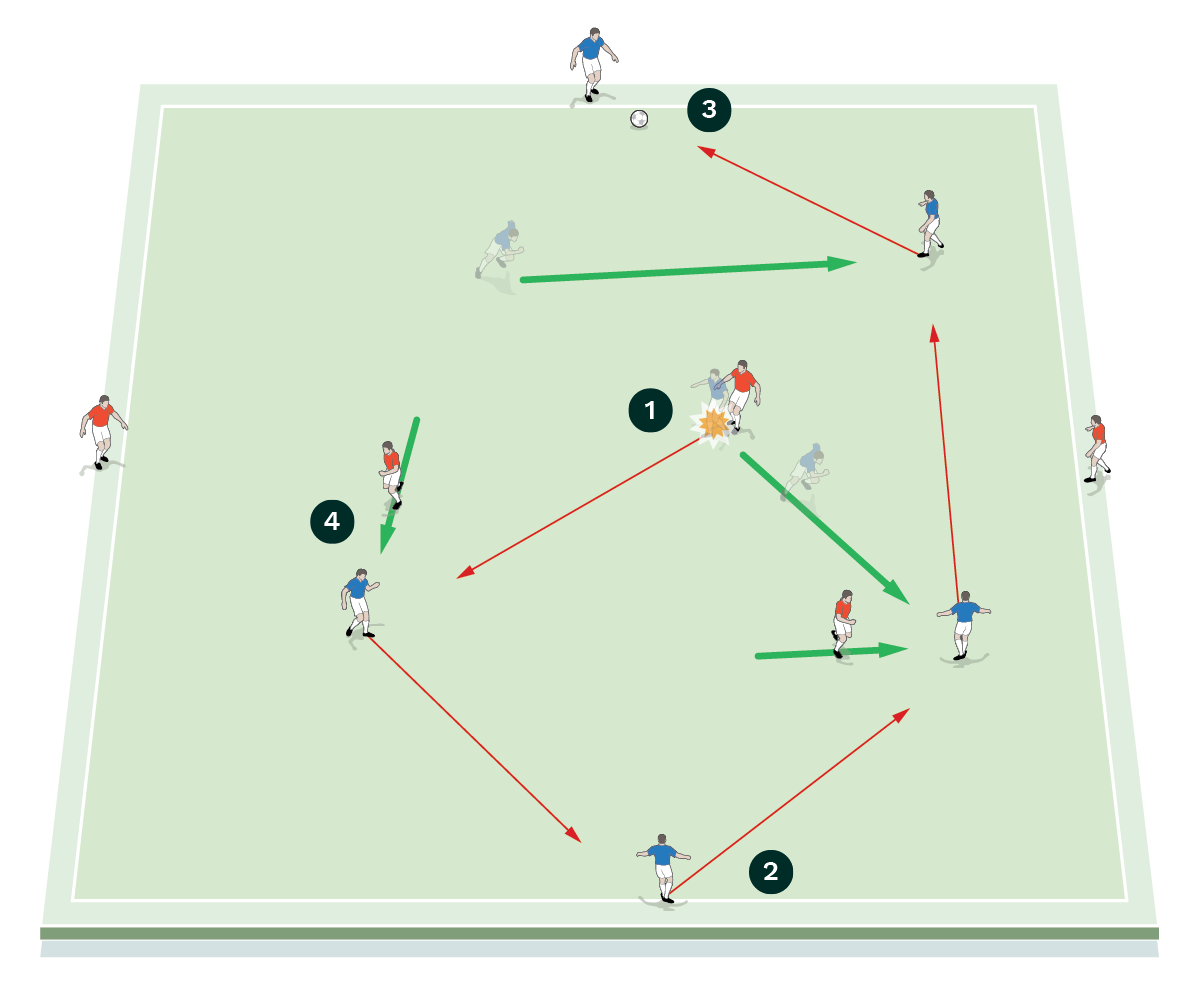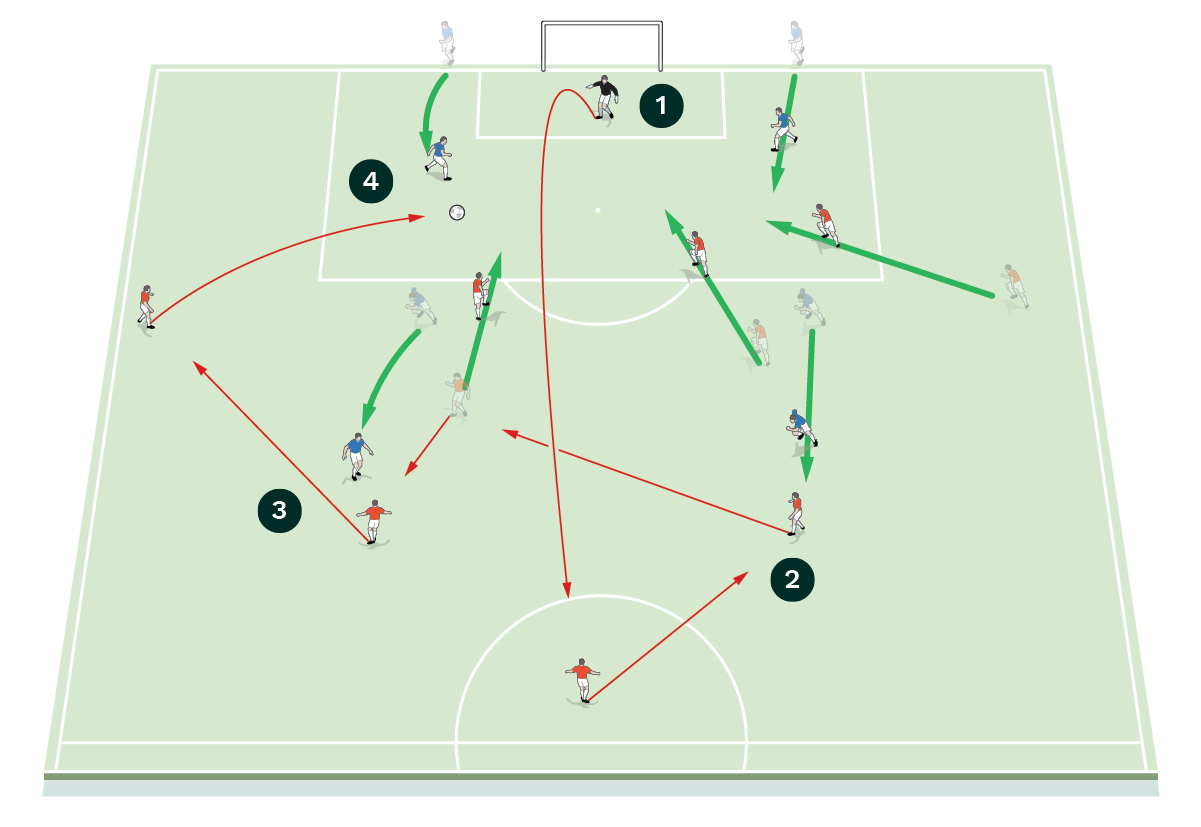You are viewing 1 of your 1 free articles
Combination play in the final third
| Area | Up to half a pitch |
| Equipment | Balls, bibs, cones, 1 full size goals |
| No. of Players | Up to 20 players + 2 goalkeepers |
| Session Time | End to end passing: 10mins Patterns of play: 12mins 11v11 game: 20mins [not shown] |
This training session is all about encouraging combination play in the final third and it provides the attacking players in our team with different patterns of play to help them get behind the opposition’s defence.
It gives the forward players numerous attacking options and a variety of patterns of play to create opportunities to score in the final third, while the opposition defend to make it a realistic experience.
We would progress this pattern of play practice by going straight into an 11v11 to test that the players understand all of the coaching points in a real opposed game situation.
We would probably run this session on an “in possession” day on Match Day -2 We would do this in order to paint some pictures for our players to help them to exploit space against the opposition.
“This session gives the forward players numerous attacking options and a variety of patterns of play to create opportunities to score in the final third”
END TO END PASSING
We set up a playing area of 18x18 yards. Depending on numbers we would usually have two squares set up. We’re using ten players in each square, split evenly into two teams of five. Each team has three players in the centre of the square and two end players who are positioned at opposite ends of the area, as shown.
The ball starts with an end player passing to a team mate inside the square and then the teams play 3v3 in the middle of the area, with the team in possession looking to move the ball from one end player to the other to score a point. The out-of-possession team presses and aims to win the ball, as shown [1a].
[1a]

- The ball starts with a red end player passing to a team mate inside the square
- The reds look to move the ball from one red end player to the other
- The blues press and try to win the ball back
“The coaches should encourage the players to use one-touch combination play and allow them to be as creative as possible”
If the out-of-possession team wins the ball back, they then look to quickly play it to one of their end players. When the end player receives the ball, it should be played back to a team mate in the square and the team should try to move it from one end player to the other while their opponents press and try to win it back, as shown [1b].
[1b]

- If the blues win the ball back, they then look to quickly play it to one of their own end players
- When the blue end player receives the ball, it should be quickly played back to a team mate in the square
- The blues aim to move the ball from one end player to the other to score a point
- The reds press and try to win the ball back
Every 45 seconds, the end players should swap roles with a player in the middle.
The coaches should encourage the players to use one-touch combination play and allow them to be as creative as possible, giving them the freedom to express themselves and explore the activity. They should also encourage players to use the correct angles to play the ball forwards.
PATTERNS OF PLAY
We set up a playing area on half a pitch with a goal and a goalkeeper at one end. We’re using 11 outfield players, split into a blue defending team of four and a red attacking team of seven. The attacking team is made up of two wing backs, three central midfielders and two strikers.
The blue goalkeeper starts play by clipping the ball to the deepest lying opposition central midfielder. The red team then execute a passing pattern. The receiving midfielder plays the ball to the right sided central midfielder, who plays it to a striker. The striker lays it off to the left sided central midfielder, who plays it to the wing back. The wing back crosses the ball in for the other wing back and the strikers to run onto and finish with a shot on goal, as shown [2a].
[2a]

- The blue goalkeeper starts play by clipping the ball to the deepest lying opposition central midfielder
- The receiving midfielder plays the ball to the right sided midfielder, who plays it to a striker
- The striker lays it off to the left sided central midfielder, who passes to the wing back
- The wing back crosses for the other wing back and the strikers to run onto. One of them should finish with a shot on goal
Play then resets for a second pattern of play. This time a blue defender starts the play, clipping the ball to the deepest lying central midfielder and then sprinting to the edge of the penalty area to defend. The receiving red midfielder plays the ball to the left-sided central midfielder before receiving it back and hitting a diagonal pass for the wing back to run onto. The other central midfielder makes a straight forward run into the area to join the attack and receives the ball near to the byline and crosses, as shown [2b].
[2b]

- Play resets. This time a blue defender starts play by clipping the ball into the deepest lying opposition central midfielder and then sprints to the edge of the penalty area to defend
- The receiving midfielder plays the ball to the left-sided central midfielder before receiving it back and hitting a diagonal pass for the wing back to run onto
- The other central midfielder makes a straight forward run to join the attack
- The central midfielder makes a forward run into the area and receives the ball from the wing back near the byline and crosses for a team mate to finish from
- The strikers anticipate the cross by making attacking runs into the penalty area
If the blue defending team wins the ball, play should reset and the pattern of play would be run again.
We would run both patterns down each side of the pitch. To help players understand, we could start by running the patterns using only passive pressure or perhaps slight pressure from the opposition before progressing to make the defenders fully active. We could also add extra defenders to make it realistic and fully opposed.
COACHING POINTS
What are the key things to look out for?
What we want to see, technically speaking, is the number 8 making the correct movement to receive and being in the correct pockets of space. Making first touch passes is also important, as is the quality of the crossing.
We want to see players timing their movements perfectly in order to break lines and wing backs should get high and wide. We also want to see good movement in the penalty box from forwards to cover all areas – front, middle and back.
What are the typical mistakes players might make and how do I avoid them?
Typical mistakes made by players include the timing of their movements or the quality of their passing or touch. Sometimes players fail to move as the ball is moving – the movement in this session needs to be as real as possible.
Related Files
Editor's Picks
Deep runs in the final third
Using the goalkeeper in build-up play
Pressing principles
Intensive boxes drill with goals
Penetrating the final third
Creating and finishing
My philosophy
Pressing initiation
Compact team movement
Coaches' Testimonials

Alan Pardew

Arsène Wenger

Brendan Rodgers

Carlos Carvalhal

José Mourinho

Jürgen Klopp

Pep Guardiola

Roy Hodgson

Sir Alex Ferguson

Steven Gerrard
Coaches' Testimonials

Gerald Kearney, Downtown Las Vegas Soccer Club

Paul Butler, Florida, USA

Rick Shields, Springboro, USA

Tony Green, Pierrefonds Titans, Quebec, Canada
Join the world's leading coaches and managers and discover for yourself one of the best kept secrets in coaching. No other training tool on the planet is written or read by the calibre of names you’ll find in Elite Soccer.
In a recent survey 92% of subscribers said Elite Soccer makes them more confident, 89% said it makes them a more effective coach and 91% said it makes them more inspired.
Get Monthly Inspiration
All the latest techniques and approaches
Since 2010 Elite Soccer has given subscribers exclusive insight into the training ground practices of the world’s best coaches. Published in partnership with the League Managers Association we have unparalleled access to the leading lights in the English leagues, as well as a host of international managers.
Elite Soccer exclusively features sessions written by the coaches themselves. There are no observed sessions and no sessions “in the style of”, just first-hand advice delivered direct to you from the coach.









